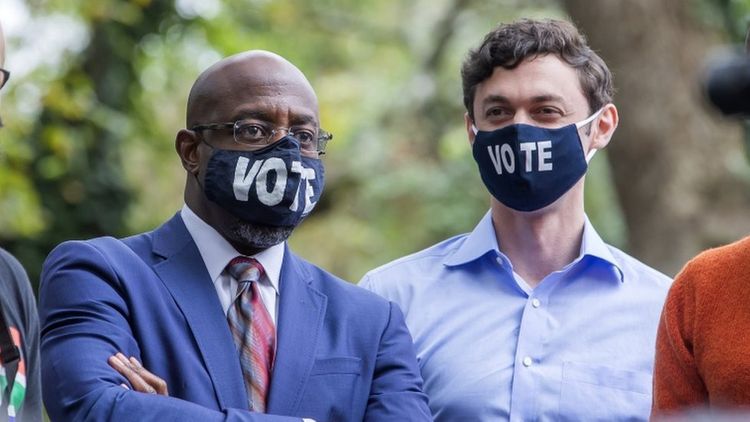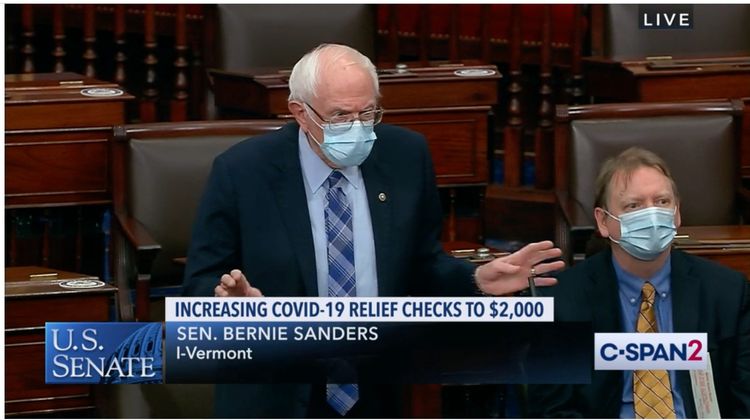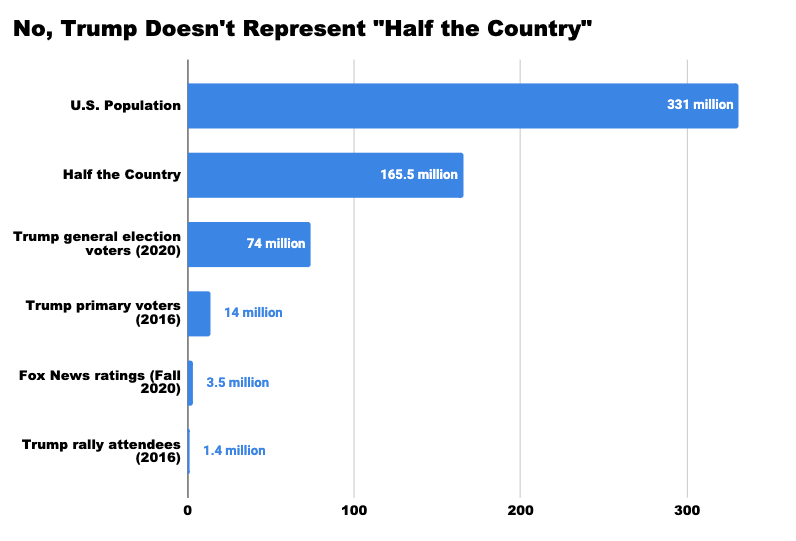There is No General Public: Starting with Audience for Stronger Science Communication Plans

When people say they want to reach the “general public,” I have to admit that I tend to grimace just a bit. General publics are a squishy concept and massively general audiences can be hard to reach with any science communications effort, especially one with limited resources.
It’s much more effective for science communicators to focus on specific audiences, instead. And there a few key questions science communicators can ask themselves when embarking on the first phases of a project to figure out who their audiences really are and how they can reach them.
The post below covers how I tend to approach identifying an audience and planning a science communications campaign designed to effectively reach them. In addition to the post, I’ve also created a Google spreadsheet planning template with examples. You can download them as a PDF, too.
There is no general public, or at least they’re harder to reach nowadays
So many of our assumptions about communication are still grounded in the old world of big, legacy broadcast and print media. Until the digital revolution of the 2000s, Americans generally shared a broad, baseline, coastal-tinged version of reality thanks to network news and big national newspapers. But that shared reality has been fracturing, meaning we have many overlapping specific publics and no real general public anymore.
For instance, while millions of people still tune into major network newscasts, viewership for those programs has declined dramatically over the past 30-plus years. Since the early 1990s, the percentage of Americans who watch the major nightly newscasts has fallen from about 60 to 27 percent. Further, the number of people employed by online-only news outlets just surpassed the number employed by legacy newspapers.
[caption id=”attachment_1422" align=”aligncenter” width=”516"]

That is literally the way it was. We don’t live in Cronkite’s media world any more, but sometimes assume we do. (Source: NASA.gov)[/caption]
Similarly, the original broadcast of Carl Sagan’s Cosmos received a 9.1 rating, meaning about 9 percent of all households with a television tuned in. By contrast, the Neil deGrasse Tyson and Seth MacFarlane reboot received a rating of 2.9. Both of these were smash hits; both of them were great pieces of science communication, but Sagan’s Cosmos was broadcast in 1980. Thirty-four years later an equally great effort only had a third of the reach.
Of course, a major television network documentary series is the pinnacle of mass science communication. Few of us have access to the kind of resources one needs to pull something like that off, anyway. And science coverage on major network news is just a small part of what those outlets focus on.
Further, what we didn’t have thirty years ago was a globally linked web-based information network. Being able to reach specific audiences more directly — for instance through sites devoted to science news, water quality, battery technology or healthy eating for toddlers — is an incredibly powerful thing. It means we can tailor our efforts much more so than we used to be able to, but it also means we have to do more work finding our audience and figuring out where they get information.
Successful communication starts with your audience
Good science communication efforts start with identifying a priority audience and a desired goal. The questions I like to focus on fall along the following lines:
- Who is the audience?
- What is the audience like?
- What will the audience know or do?
- What channels does the audience use to get information?
- How can a science communication campaign get into those channels?
Who is the audience?
Audiences might include scientific peers, policy makers, funders, communities affected by scientific research findings, or participants in citizen science projects. It’s up to scientists, managers and communications staff to decide how many of these audiences are truly important and worth prioritizing.
[caption id=”attachment_1424" align=”aligncenter” width=”640"]

There is no mountain tall enough and no megaphone big enough to reach every audience. (Though I’m sure a physicist could factcheck that for me!) Source: GettyImages.[/caption]
Of course, these audiences can and do cross-over with one another and good science communication plans can and will have multiple audiences. But going overboard and trying to reach too many audiences at once can dilute the effectiveness of a plan. That’s why when I do communications planning, I like to identify priority, secondary and tertiary audiences.
It’s also worth bearing in mind that for scientists, the primary audience is usually their peers. Communicators who neglect that will often wind up talking past their scientist colleagues, as I’ve written about before.
But back to those other audiences. Say a group is studying drought in Southern California and wants to reach individual homeowners to help educate them about the most effective water conservation steps they can take at home. Or perhaps they want to recruit them for a study about water use. That’s a somewhat specific audience, but it can be narrowed down even further. Are we talking about apartment dwellers or people with detached houses? Are we talking about homes that were recently constructed or ones with old plumbing? Those kinds of questions can lead to geographic and socioeconomic filters for figuring out one’s primary audience and how best to reach them.
Or consider an effort aimed at reaching coastal policy makers. That’s a broad category which could include everyone from the Army Corps of Engineers to my old Congressman in New Jersey and the mayors and town councils that dot the Jersey Shore.
Is a researcher studying coastal policy-making as it relates to state and national parks? Perhaps proximity to those natural resources is a good way to narrow the audience even further. Are they studying how communities recover from flooding? Towns and cities that experienced significant flooding in the past few years are much more likely to be interested than ones that have stayed dry for a decade or longer.
Is it an audience of funders? In that case, there may be an established funding process that scientists need to follow, making this task a bit clearer. But maybe they’re seeking corporate or foundation funding from smaller institutions without set protocols and need to think more specifically about who controls the various purse strings at those institutions.
Getting specific about audience at the outset allows communicators and scientists to more effectively develop and deploy their — often limited! — resources.
What is the audience like?
When we do planning in science communication, it’s easy to overlook this question because we might share some basic assumptions about an audience that we’re not used to articulating or challenging. But if we step back and start thinking objectively about our different audiences, we can do a better job reaching them where they’re at, avoiding pitfalls and using resources effectively.
[caption id=”attachment_1423" align=”alignnone” width=”960"]
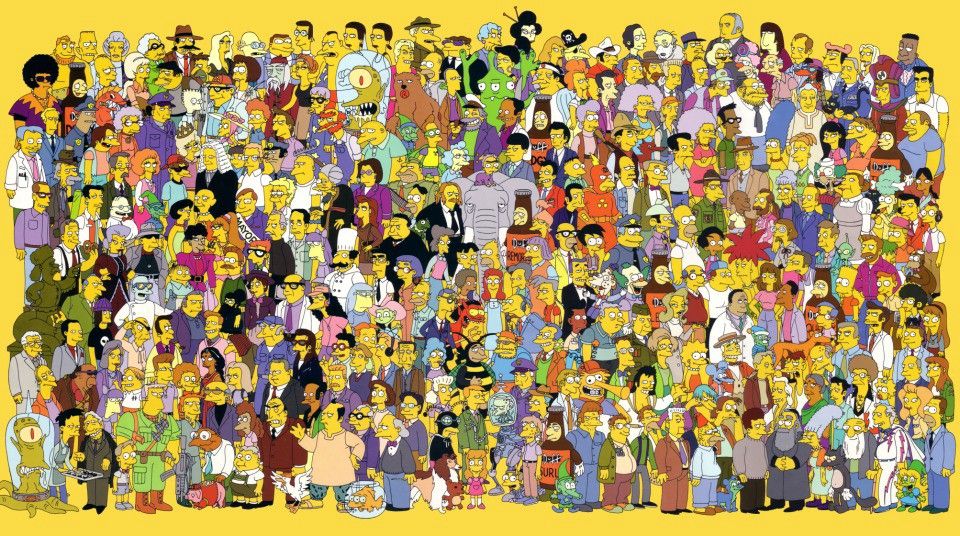
Imagine you list your audience as “Simpsons characters.” D’oh! They’re all quite different, so if your audience is that broad, the only thing they might have in common is general antipathy toward Shelbyville.[/caption]
How old are they? An audience in their 60s is going to be a lot more comfortable with mainstream media coverage and Facebook than Instagram and Twitter.
What do they already know about what you work on? Explicitly stating the assumptions — or lack of assumptions — an audience may have about a scientific topic can be an enlightening exercise. Apartment dwellers whose water bills are baked into their rent may have barely thought about water use in their home before. People who garden and maintain their lawns may feel like they already know a lot about how much water they use and will filter information about a new water-use study through that lens.
What’s their class and education level? Blue collar and white collar communities speak different languages and have different concerns. Saving a few bucks a month on a water or electricity bill is likely to be more motivating for a blue collar family than a white collar one. Conversely, a white collar family may have the luxury of worrying about remote environmental concerns since their own air and water is relatively clean while a blue collar family may be more focused on the here and now and their own backyards.
How much do they trust scientists or a given scientific institution? A UCLA study will carry a lot more weight in Pasadena than one from Ohio State or Harvard, regardless of the quality of the data or the nature of the conclusions. Similarly, a federal agency may have fraught relationships in a given area for reasons that have nothing to do with a project at hand, but a company or local NGO it’s partnering with may not and could ultimately be a stronger messenger.
Does politics matter? Once people start looking at a scientific topic through a political or ideological lens, science communicators have to account for that context. Trying to “science” at people who view a topic as something that’s tied to their deeper ideological beliefs and values almost never works. Instead, science communicators have to think about where they and their audience share beliefs and values and who they might partner with from outside the scientific community to foster more values-based communication that’s still grounded in the facts.
What will the audience know or do?
Again, this is a question that often goes unasked when doing communications planning. Science communication must be good, we think, so we want to do more science communication. But to what precise end? Or put more simply, why the heck are we doing communications about this in the first place? Successfully answering this question leads projects to the quality metrics that a campaign can and should measure as much as possible.
Communications is rife with shallow metrics, from impressions to reach to page views and downloads and eyeball time. It’s no good to swim in data that isn’t useful. Knowing that more people are sharing an organization’s posts on Twitter over time tells us so little about who those people are or why their sharing tendencies serve a deeper goal, but we treat that trend as a great success none the less.
So what do we really want people to think, feel, or do in response to a communications effort? Reactions can vary!
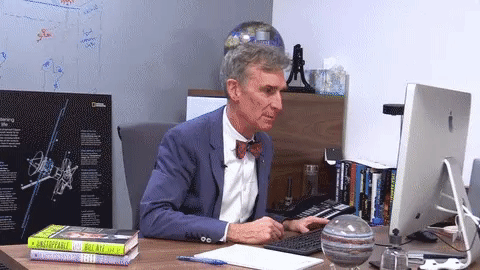
[caption id=”attachment_1425" align=”aligncenter” width=”480"]
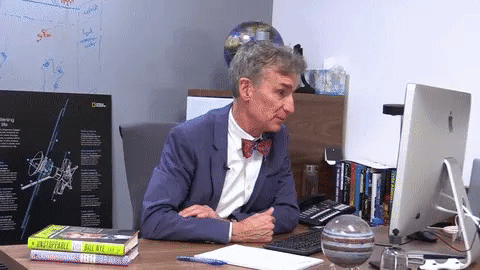
Bill Nye watching C-Span hearings and SpaceX launches, respectively. (Source: FastCompany)[/caption]
Consider some of these possible goals and questions. Do you want an audience to:
- Vaccinate their kids? A campaign could have a before-and-after set of stats on vaccination rates that gets to how effective the communication was. Indeed, metrics like this are about as real as it gets. Of course we don’t all work on vaccines, so sometimes it’s useful to think: “How would I think about this if it were a public health campaign?”
- Develop a deeper appreciation for scientific research funding? This is squishier, but measures could include public opinion polls, how policymakers vote or even overall levels of funding year to year with controls for other variables.
- Understand the long-term toll water pollution is taking on a community? Again, this could be measured through polling. Or perhaps it could be measured through the number of public comments an agency receives over time or the number of people who show up to regular meetings about water quality before and after a communications effort is deployed.
- Be overwhelmed by splendorous images from a space telescope? Okay, that would be a fun project. Perhaps it could be measured through not just how many times those images are viewed online but also how often they are shared and the sentiment of the commentary that goes along with those shares. If a museum is sponsoring such a project, maybe their ultimate goal is to turn those online shares into in-person visits, donations and other kinds of support for a museum’s mission.
Measuring the efficacy of communications campaigns is so important and it doesn’t happen often enough. In the post-Walter-Cronkite world, it’s no longer-sufficient to “get the message out there.” The message needs to be delivered effectively and accurately to an audience that can use it. That’s what counts, especially in such a noisy media environment.
What channels does the audience use to get information?
The digital media revolution means that people’s attention is divided and highly segmented, so that means communicators have to think more and more specifically about where people will see and hear information related to their work.
[caption id=”attachment_1428" align=”aligncenter” width=”723"]
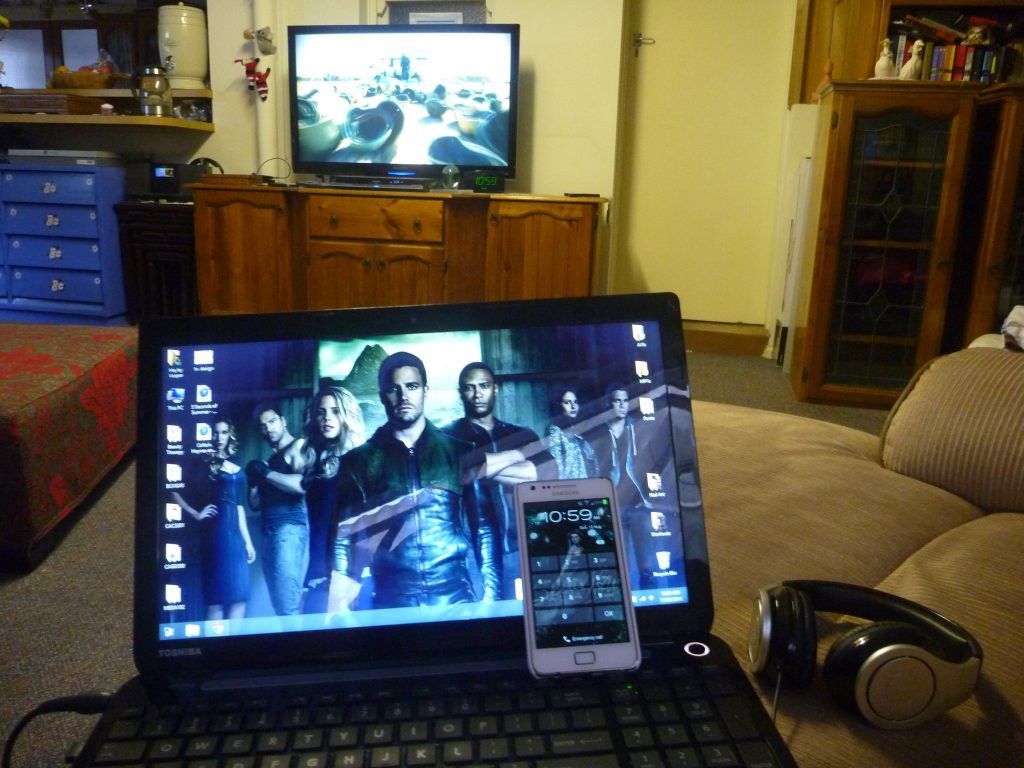
All of us. (Source: hayleyanne93.wordpress.com)[/caption]
Media
Local papers, radio and television stations are the mainstays of most science communications efforts. Location matters. Or in social science terms, media has a proximity bias. For instance, a public lecture from a principal investigator could absolutely be of interest to a local paper even if it’s a pass for a regional daily.
I also tend to think of science-focused and trade media as being on an adjacent track to general interest media. Not only are trade outlets more likely to cover a science or technical story for an engaged audience, but they’re also where a lot of general interest journalists and outlets learn about new happenings in a given field. In fact, trade journalists all have stories of mainstream outlets seemingly (and actually!) copying their ideas without attribution.
That said, science communicators instinctively turn to the media as the chief place to get coverage and validation for their work. That’s often right. But other channels can be equally or even more valuable depending on the audience.
Blogs
Local or speciality blogs can be more powerful than mainstream media outlets for connecting with a very specific audience. An influential regional real-estate blog might be a perfect fit for talking about water conservation precisely because of the property owners, managers and prospective property owners who read the blog. A lot of blogs are also happy to have people guest-post, presuming they’re on topic and add value for that blog’s audience.
Science bloggers at mainstream outlets, places like Scienceblogs.com, and folks who blog on their own are also a great option for reaching the “science-engaged” public, though they naturally have their own interests and idiosyncrasies, as we all do.
Email, websites and social media
Every science communication project should have an email list and a website for direct communication and showing up in search results about a project, respectively.
Selecting which social media channels to publish on is an important choice; picking too many can be a time-consuming hassle. Picking the 1 to 3 channels a primary audience uses, or 1 channel each for primary and secondary audiences can be a reasonable choice. For instance, a scientific project working with a variety of community groups that already have strong Facebook followings should join that network. At the same time, they may be publishing educational videos for a K-12 audience that are a natural fit for Youtube, so they’d want to join that community and consider potential collaborations with established channels.
Channels for policymakers
Many times, people assume they have to get media coverage for a policymaker to care about a topic. That’s not always true. Science communicators should never forget that the simplest way to get to a policymaker is to call their office and ask for a meeting. It can really be that easy. Of course, every policymaker is different and even at the local level, they can feel like they’re drinking from a firehose when it comes to people hitting them up with information they think is important.
Get creative
Going back to the example of a water use study, a campaign might consider reaching homeowners. Who tends to own homes? People with kids. So communicating with parents through a PTA meeting or a school list-serv might be a good, indirect way to reach that audience. And it might even get to a given audience more efficiently than attempting to contact a local newspaper and hoping that they’ll cover a project.
Similarly, we shouldn’t be afraid to try things that are different. The CDC made a big splash several years ago when it repackaged its disaster preparedness advice as if it applied to a zombie apocalypse. Super-brave for a federal agency and super-effective. NOAA should also be commended for a genuinely funny press release in which they advised beachgoers that there is no selfie-stick long enough to safely take pictures with baby seals. Generating ideas for creative campaigns like that is tough, of course. Two good resources to help prompt some potentially powerful ideas are Contagious by Jonah Berger (affiliate | non-affiliate) and The New Rules of Marketing and PR by David Meerman Scott (affiliate | non-affiliate).
Avoid shiny objects
There’s so much cool stuff going on in digital communication now it’s easy to overthink format at the expense of message and audience. For instance, developing an app, an online game or a Pinterest board might be a good fit for a campaign. Or it might not. Who will use the app and why? Who will play the online game and what message will they take away from it? Are we trying to reach an audience that uses Pinterest already or will using that network be a barrier to entry from some of our audience members?
We shouldn’t adopt new communications tools simply because they’re new. We should adopt them because they make sense for our audiences.
Picking a good mix
Your audience might be getting information from ALL these sources, including Pinterest, the New York Times and their homeowner association’s Facebook page. Or some super hip social network that got invented five minutes ago. Effectively reaching an audience usually means using a mix of communications channels, each of which will have advantages and drawbacks and varying levels of resource and time commitment associated with them.
How can a science communication campaign get into those channels?
This step is where communications planning — and ambition — starts to turn into action. That can be a good thing and a bad thing. For instance, if a campaign is thinking too broadly about its audience, it may realize it’s trying to bite off more than it can chew; maybe they really can’t reach a million people with new and awesome space data visualizations in just two months. But maybe they can, especially if they can successfully pitch a few of the big news outlets that cover space or reach out to big-time astronomy Tweeters. But to do that, the campaign needs email addresses, introductions, handles and other ways to be in touch with the folks who control those channels.
At this point in planning, the amount of staff time involved can vary widely. If a campaign already has a relationship with a beat reporter it may not be very time-consuming at all to reach out to them and help them do a story related to the topic at hand. If they have no relationship, building one and getting on someone’s radar can and should take more time.
Finding out who to contact at a news outlet usually requires some time on Google and Twitter. While there are useful, powerful press databases out there (Vocus is the industry leader), there is no good substitute for reading a journalist’s work and deciding whether or not it makes sense to pitch them. People who work in media are inundated with off-base pitches; thoughtfully narrow pitches are almost always a better bet, especially for resource-strapped science communicators.
Along a different track, if a campaign decides something like in-person PTA meetings are the way to go, they need to start figuring out who runs each of those meetings. For local outreach like that, Facebook and LinkedIn are useful for mapping a network and seeing if staff members know anyone who knows anyone who can make an intro. Just don’t be creepy about it!
Additionally, when plans get to this level of figuring out who to reach out to and how, the benefits of prioritization become quite evident. Perhaps an audience that’s very hard to reach becomes secondary instead of primary. Once a plan starts accounting for how much time it takes to really do the communications work for various audiences, it becomes clear that not all audiences are going to get the same amount of time and attention.
Under-planning, over-planning, revisiting assumptions and adapting
It’s tough to find the sweet-spot for how much time we need to spend developing and honing a communications plan. That said, there are some hallmarks of under-planning and over-planning that are worth watching out for.
Under-planning usually involves focusing too much on a shiny communications object, say a video, a specific event or someone’s pet idea. These sort of one-off communications efforts can work, but it’s harder for them to have a sustained impact for an audience. Under-planning can also involve metric-chasing, the process by which we mysteriously start to get super-excited by the number of times something is shared on social media instead of asking ourselves who is sharing it and to what end.
Over-planning is more rare, at least in my experience. Communications is all too often an afterthought in scientific endeavors.
The most common form of over-planning I’ve run into is a focus on what haters or trolls will say about a given project. The short answer is they will probably cast aspersions in their corner of the Internet then move onto the next thing they want to get mad about. It’s not worth shaping a significant portion of a communications plan around the reactions of an unpersuadable audience.
I’ve also occasionally run into paralysis-by-analysis. There are few easy answers in communication and it’s tempting to think that paying for more polls, more focus groups, or doing another round of internal or stakeholder feedback will somehow produce them. At some point, communicators have to stop planning and start learning by doing.
In some cases, campaigns will actively plan for learning-by-doing by picking one or two small efforts to deploy in the real world. That’s smart and it can help communicators efficiently deploy resources at later stages of a campaign.
Overall, I prefer to do adaptive planning like that. Rather than assuming we can release science communications efforts into the world and watch the results trickle in, we have to be both proactive and reactive. Doing so requires regular check-ins to respond to audience feedback (or silence!) as it comes in. It also requires big-picture check-ins — perhaps on a quarterly or annual basis — to revisit all these assumptions about audiences, goals and the kinds of results we really want to see.


